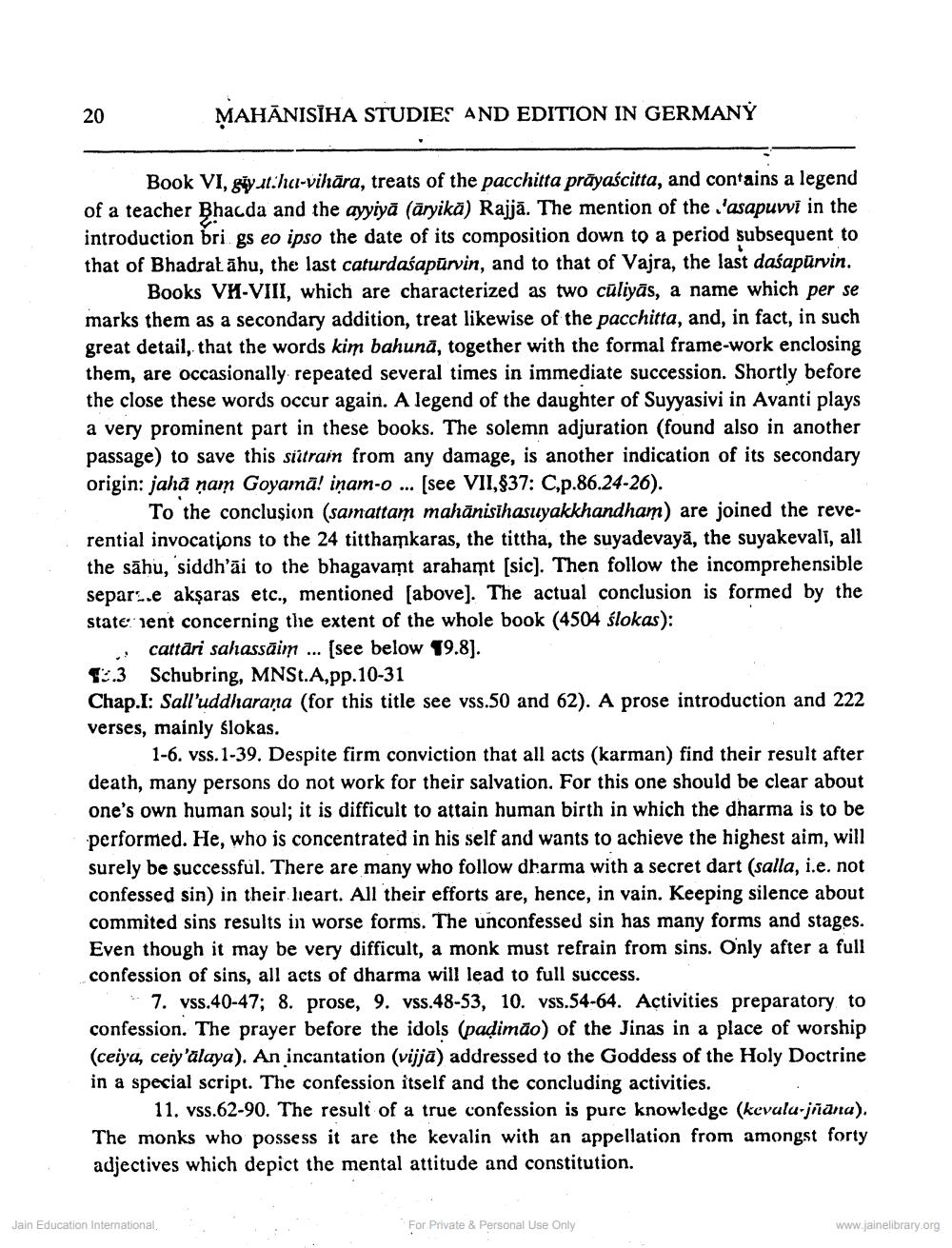________________
20
MAHĀNISĪHA STUDIES AND EDITION IN GERMANY
Book VI, siyut:hu-vihāra, treats of the pacchitta prāyaścitta, and contains a legend of a teacher Bhacda and the ayyiyā (āryika) Rajjā. The mention of the 'asapuvvi in the introduction bri gs eo ipso the date of its composition down to a period subsequent to that of Bhadrat āhu, the last caturdaśapūrvin, and to that of Vajra, the last daśapūrvin.
Books VH-VIII, which are characterized as two culiyās, a name which per se marks them as a secondary addition, treat likewise of the pacchitta, and, in fact, in such great detail, that the words kim bahună, together with the formal frame-work enclosing them, are occasionally repeated several times in immediate succession. Shortly before the close these words occur again. A legend of the daughter of Suyyasivi in Avanti plays a very prominent part in these books. The solemn adjuration (found also in another passage) to save this siitrain from any damage, is another indication of its secondary origin: jahā ņam Goyamā! inam-o ... (see VII,837: C,p.86.24-26).
To the conclusion (samattam mahānisihasuyakkhandham) are joined the reverential invocations to the 24 titthamkaras, the tittha, the suyadevayā, the suyakevali, all the sāhu, siddh'āi to the bhagavamt arahamt (sic). Then follow the incomprehensible separ..e akşaras etc., mentioned (above). The actual conclusion is formed by the state nent concerning the extent of the whole book (4504 ślokas):
,,cattari sahassāim ... (see below 19.8). $3.3 Schubring, MNSt.A, pp.10-31 Chap.I: Sall'uddharaṇa (for this title see vss.50 and 62). A prose introduction and 222 verses, mainly slokas.
1-6. vss. 1-39. Despite firm conviction that all acts (karman) find their result after death, many persons do not work for their salvation. For this one should be clear about one's own human soul; it is difficult to attain human birth in which the dharma is to be performed. He, who is concentrated in his self and wants to achieve the highest aim, will surely be successful. There are many who follow dharma with a secret dart (salla, i.e. not confessed sin) in their heart. All their efforts are, hence, in vain. Keeping silence about commited sins results in worse forms. The unconfessed sin has many forms and stages. Even though it may be very difficult, a monk must refrain from sins. Only after a full confession of sins, all acts of dharma will lead to full success.
7. vss.40-47; 8. prose, 9. vss.48-53, 10. vss.54-64. Activities preparatory to confession. The prayer before the idols (padimão) of the Jinas in a place of worship (ceiya, ceiy'alaya). An incantation (vijjā) addressed to the Goddess of the Holy Doctrine in a special script. The confession itself and the concluding activities.
11. vss.62-90. The result of a true confession is pure knowledge (kevulu-jñāna). The monks who possess it are the kevalin with an appellation from amongst forty adjectives which depict the mental attitude and constitution.
Jain Education International,
For Private & Personal Use Only
www.jainelibrary.org




